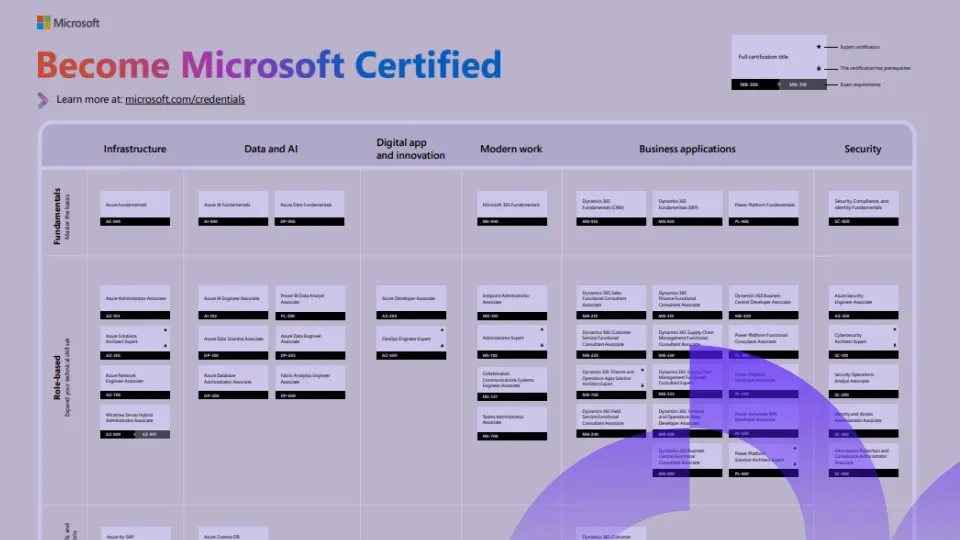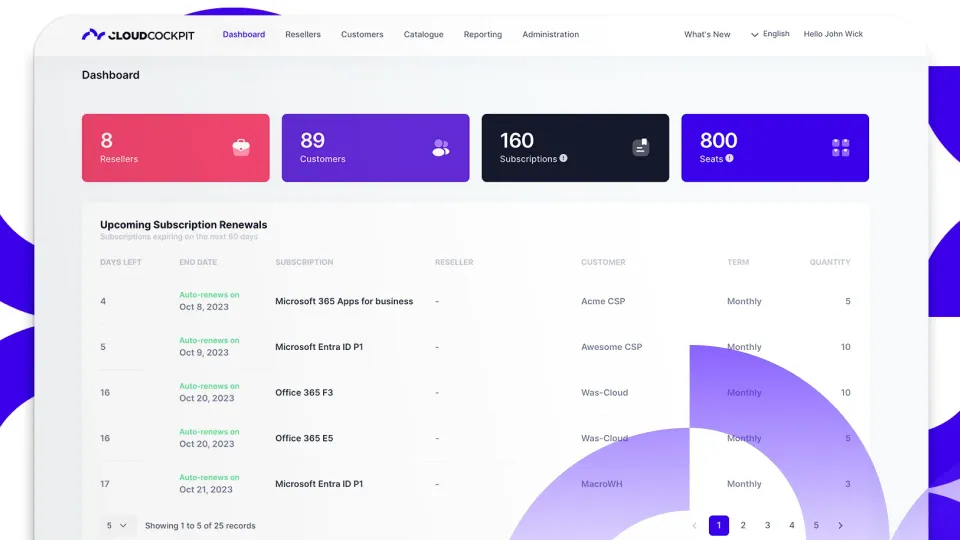Microsoft CSP Program
Welcome aboard to the Microsoft CSP Program
An overview of the Microsoft CSP Program, highlighting how partners can offer solutions like Azure and Microsoft 365, tailored to client needs.
Guidelines on best practices within the CSP Program, including sales strategies, customer management, and cost optimization for partners.
Gain insights from our decade-long market experience and direct interactions with Microsoft, offering a unique perspective on the CSP Program's impact.
The latest updates and news from the CSP Program, covering new features, policy changes, and emerging opportunities
Table of Content:
1. Microsoft CSP Program: A Comprehensive Guide for Potential Partners
2. Introduction to the Cloud Solution Provider Program
3. Leveraging Azure Cost Management for Optimal Cloud Efficiency
4. Mastering Microsoft CSP: A Guide to Unlocking Customer Subscription Success
5. Price List Preview and Change Frequency
6. Microsoft Certification
1. Microsoft CSP Program: A Comprehensive Guide for Potential Partners
Introduction to the Microsoft CSP Program
The Microsoft Cloud Solution Provider (CSP) Program stands as a robust platform for selling cloud solutions, enabling partners to offer Microsoft's products and services, including Azure, Microsoft 365, and Dynamics 365. This program is pivotal for cloud strategies, aiding in augmenting existing offerings and meeting specific customer needs.
How the CSP Program Works
Partners have two paths to resell Microsoft products: directly, by fulfilling all requirements to purchase solutions directly from Microsoft, or indirectly, through a distributor. This flexible business model empowers partners to manage the entire customer lifecycle, enhancing relationships with resellers and customers by providing positive experiences at every stage.
Relevant Insights:
- Two pathways for reselling: Direct (meeting Microsoft's criteria) and Indirect (through a distributor).
- Enables comprehensive management of the customer lifecycle.
- The flexibility to choose between direct and indirect sales models caters to different types of partners, varying in size and capabilities.
- Direct partnership often requires a higher level of commitment and resources but offers greater control and potentially higher margins.
Impact:
- This model significantly impacts customer satisfaction and loyalty by allowing partners to provide tailored solutions and support.
- It also influences the partner's ability to scale and adapt to market changes quickly.
Relevance:
- In the rapidly evolving cloud market, having a flexible and adaptable sales model is crucial for staying competitive.
- It ensures that partners can meet the diverse needs of their customer base and respond to technological advancements effectively.
CSP Program Benefits for Businesses
Becoming a Microsoft CSP partner grants access to exclusive technical and business resources, including management tools, marketing and sales resources, and opportunities to co-create case studies with Microsoft. This elevates brand visibility and credibility, in addition to strengthening customer relationships.
Relevant Insights:
- Access to exclusive technical and business resources.
- Utilization of marketing, and sales tools.
- Opportunities for co-creation of case studies with Microsoft.
- These resources are designed to empower partners, providing them with a competitive edge by enhancing their technical capabilities and business acumen.
Impact:
- Access to these resources can significantly improve a business's operational efficiency, market reach, and customer satisfaction levels.
Relevance:
- In the fast-paced and competitive cloud market, these benefits are crucial for businesses looking to differentiate themselves and build a sustainable, profitable partnership with Microsoft.
Requirements for Becoming a CSP Partner
To become a CSP partner, an active account in Microsoft's cloud AI partner program is required, along with the authority to sign legal agreements on behalf of your organization, and the ability to provide first-level cloud product support to customers.
Relevant Insights:
- Active account in Microsoft's Cloud AI partner program.
- Legal authority to sign agreements on behalf of your organization.
- meet at least USD300K in Cloud Solution Provider program annual revenue
- Capability to offer first-level cloud product support.
- These requirements ensure partners are prepared and qualified to deliver Microsoft cloud solutions effectively.
- Access here to learn more
Impact:
- Meeting these criteria positions your business as a trusted and capable provider in the cloud marketplace.
Relevance:
- As cloud services continue to evolve, aligning with Microsoft's standards ensures you are at the forefront of technology and service excellence.
Cost Management and Optimization in CSP
Cost efficiency is a crucial pillar of the CSP program, focusing on tools and strategies to monitor and optimize resources, maximize performance, and fully leverage cloud infrastructure.
Relevant Insights:
- Utilization of monitoring tools for resource usage.
- Strategies for optimizing cloud resource allocation.
- Techniques to maximize cloud infrastructure performance.
- Effective cost management in CSP involves both technical tools and strategic planning to ensure resources are used efficiently, avoiding unnecessary expenses.
Impact:
- Implementing these practices can lead to significant cost savings, improved system performance, and a better allocation of resources, directly affecting the bottom line of both partners and their customers.
Relevance:
- As cloud adoption grows, the ability to manage and optimize costs becomes a competitive differentiator, enabling businesses to offer more value to their customers while maintaining profitability.
Support and Resources Available for CSP Partners
The CSP program offers specialized technical support and marketing and sales resources to promote CSP solutions and expand market reach. It's noteworthy that partners are responsible for direct interaction with customers and for providing support.
Relevant Insights:
- Access to specialized technical support.
- Marketing and sales resources to enhance visibility.
- Partner empowerment for direct customer interaction.
- These resources are crafted to bolster the partner's ability to deliver exceptional service and support, aligning with Microsoft's commitment to partner success.
Impact:
- Partners equipped with these resources can better serve their customers, leading to increased satisfaction and loyalty.
Relevance:
- In a competitive cloud market, having the right support and resources is critical for standing out and ensuring long-term success.
Your Partners on Microsoft CSP Universe
2. Introduction to the Cloud Solution Provider Program
In the ever-changing digital environment, the demand for cloud-based services is skyrocketing. Microsoft has recognized this need and offers an unparalleled opportunity for partners of every size with its Cloud Solution Provider (CSP) program.
This program is an invitation for partners to enter the cloud market seamlessly, eliminating the complexity of dealing with multiple vendors or the need for a comprehensive customer relationship management system.
Impact:
- This initiative opens up new revenue streams for partners, enabling them to offer a broad spectrum of Microsoft cloud services and solutions directly to their customers.
Relevance:
- As businesses continue to shift towards cloud solutions, being part of the CSP program positions you as a key player in this transformative era.
Completing Your CSP Application
Embarking on your CSP journey requires some preparation. Gather essential company information including your PartnerID, complete business address, banking details, and a work email for the employee who will manage the Partner Center.
This preparation simplifies the application process.
Steps for Application:
- Sign In: Use your Microsoft Entra tenant credentials to access the Partner Center.
- Associate PartnerID: Connect your profile with your unique PartnerID.
- Enter Company Information: Opt for automatic DUNS ID lookup or enter details manually.
- Verification Process: Including automatic or manual entry of company details, and business address validation by Microsoft.
- Relevance: Streamlining these details ahead of time accelerates your onboarding process, allowing you to focus on growing your business.
Enrolling in the CSP Program
As CSP partners, you're more than providers; you're trusted advisors for your customers. Supporting them through challenges and inquiries not only solidifies your relationship but also grants insights into their evolving needs, enabling you to suggest impactful solutions.
Indirect Reseller Enrollment:
Benefits:
- Partners with indirect providers benefit from reduced infrastructure requirements, quicker market entry, and less operational complexity.
Impact:
- This model lowers the entry barrier for newcomers and smaller entities, fostering growth and enabling quick adaptation to customer needs.
Direct-Bill Partner Enrollment:
Benefits:
- Offers the ability to customize solutions and maintain direct relationships with customers and Microsoft, granting autonomy over billing and strategic decision-making.
Impact:
- Enhances customer loyalty and satisfaction through personalized services and support, while also providing clearer financial oversight.
CSP Program Details
CSP Regional Markets and Currencies:
Your market is determined by your business location, which influences where you can sell CSP offers. Awareness of regional markets and compliance with local regulations are crucial for strategic expansion and operational smoothness.
Restrictions and Policies:
It's important to stay updated on Microsoft's policies, including the prohibition against reselling online services within the CSP to maintain fairness and transparency in transactions.
The Microsoft Partner Agreement (MPA)
Signing the MPA is essential for all CSP program participants, outlining critical terms related to data privacy, security, and compliance. Regular verification of your PartnerID and adherence to the MPA are necessary to ensure ongoing eligibility and maintain your standing within the program.
Importance:
- The MPA is a cornerstone of your CSP partnership, embodying the commitment to maintaining high standards of privacy, security, and compliance in your business operations.
Azure Cost Management for Microsoft CSPs
3. Leveraging Azure Cost Management for Optimal Cloud Efficiency
Azure Cost Management is pivotal for Microsoft Cloud Solution Providers (CSPs) and their clientele, ensuring the meticulous management and optimization of cloud expenditures. Its significance is magnified for users with billing, subscription, or management privileges, offering a comprehensive toolkit designed for the fine-tuning of cloud costs.
Billing Models and Considerations
Comprehensive Cost Management:
- Azure Cost Management is a comprehensive tool designed for the strategic monitoring, managing, and optimizing of cloud expenses, fostering transparency and control over cloud investments.
Enhanced Financial Governance:
- It elevates financial governance, empowering organizations to maximize their cloud investment returns and optimize cost efficiency.
Impactful Features:
Granular Visibility:
- Deep integration with billing and resource management workflows provides detailed visibility into cloud spending, enabling organizations to identify and eliminate wasteful expenditures.
Strategic Cost Optimization:
- Offers tools for budgeting, cost analysis, and setting up alerts, which aid in preventing budget overruns and spotlighting cost-saving opportunities.
Operational Efficiency:
- Streamlines operations by enhancing organizational visibility and accountability, speeding up the attainment of cost optimization and efficiency objectives.
Why Azure Cost Management Matters:
Financial Control and Savings:
- By implementing key strategies like reserved instances and VM optimization, organizations can realize significant savings, improving their bottom line.
Strategic Decision-Making:
- The detailed insights provided by Azure Cost Management empower users to make informed decisions regarding resource allocation and usage, leading to more efficient cloud operations.
Optimization and Best Practices:
Proactive Monitoring:
- Utilizing budgeting tools and anomaly detection enhances the ability to manage spending effectively, preventing unforeseen expenses.
Resource Allocation:
- Applying tag inheritance and cost allocation rules allows for precise management of shared costs, further optimizing cloud expenditure.
Integration and Automation:
- Exporting data for business process automation or tool enrichment improves efficiency and streamlines workflows.
Strategic Planning for Cloud Efficiency:
Understanding Cloud Objectives:
- Effective cloud management begins with a clear understanding of the business objectives behind cloud investments and anticipating resource usage patterns.
Visibility into Spending:
- Azure's services provide comprehensive insights into where funds are allocated, highlighting underutilized resources and potential savings.
Accountability Framework:
- Assigning and attributing costs promotes accountability within teams or departments, ensuring responsible cloud spending.
Continual Improvement and Adaptation:
Iterative Optimization:
- Cost management is a dynamic process that benefits from regular review and adjustment, encouraging a culture of continuous improvement.
Strategic Resource Planning:
- Before embarking on cloud initiatives, evaluating Azure offerings against business needs is essential, enabling the selection of configurations that balance performance with cost.
Enhancing Cloud Value with Azure Cost Management
Azure Cost Management is an indispensable resource for optimizing cloud investments. It provides the tools and insights necessary for Microsoft CSPs and their customers to achieve financial efficiency and operational effectiveness in their cloud endeavors.
Subscribe to our blog
Unlock Customer Subscription
4. Mastering Microsoft CSP: A Guide to Unlocking Customer Subscription Success
This section provides a comprehensive look into managing Microsoft Customer Subscriptions, offering unique insights and practical strategies.
Our goal is to demystify the complexities of the CSP program, empowering partners to navigate with confidence. If you want to read the full blog post, we have it here: A Guide to Unlock Customer Subscription Success
The Foundation of Customer Management in CSP
Impact: Establishing a customer record in the Partner Center or using a platform such as CloudCockpit is a pivotal first step. It enables partners to offer Microsoft’s extensive catalog of Software as a Service (SaaS) products from independent software vendors (ISVs) in the commercial marketplace (Azure Marketplace).
Relevance: This step ensures that partners can deliver personalized solutions and find a way to maximize business opportunities. It's critical to note that some offers are limited to one subscription per customer, a detail verifiable on the Partner Center Price Lists page.
Only direct-bill partners or indirect providers are authorized to sell these subscriptions.
Steps for Creating Subscriptions
- Customer Selection: Choose from a list of registered customers.
- Subscription Addition: Select from the available offers in the SaaS marketplace.
- Available Filters: Refine your search to find the desired subscriptions.
- Understanding Restrictions: Essential for selecting the correct offer.
Exploring Offers with Unique Constraints
- Multi-geo Add-ons: Require a minimum number of seats based on the percentage of the customer's base seats.
- Microsoft Copilot for Microsoft 365: Maximum seat limits based on the quantity of base seats.
Customizing Subscriptions: Beyond the Basics
The strategic importance of selecting the right billing type and understanding the nuances of enterprise, small business, or trial categories, as well as navigating the constraints of unique offers, is fundamental.
Flexibility in Subscription Management: The New Commerce Experience (NCE) offers CSP partners flexibility in managing customer subscriptions, especially in adjusting license seats.
Key Partner Actions:
Increasing Licenses:
- Add licenses anytime, with billing adjustments reflected on the next invoice, offering agility to meet customer needs.
Decreasing Licenses:
- License reductions are allowed within the first seven days of any addition, ensuring swift adjustment capabilities.
Trial Subscriptions:
- Fixed 30-day terms with 25 licenses, not cancellable but with auto-renewal that can be disabled anytime. Post-expiration, they enter an "Expired" state with 30 days of retained access. CloudCockpit automatically disables auto-renewal to prevent unexpected charges.
Steps for Adjusting License Seats
- Access: Log into Partner Center or a platform like CloudCockpit.
- Select a Customer: Choose the customer needing adjustments.
- Update the Subscription: Modify the license seats on the details page.
- Submit Changes: Confirm the adjustment, with automatic recalculations for any prorated refunds if applicable.
- Coterminosity: Align new or renewed subscriptions with your term end dates for seamless management.
Upgrading Subscriptions
New commerce also introduces the ability to seamlessly upgrade subscriptions, moving customers to higher-tier services:
Types of Upgrades: Both full and partial upgrades are supported.
Process: Initiate from the Partner Center or CloudCockpit, selecting the desired subscription, term, billing frequency, and license seats.
Note that upgrades are immediate and final.
Subscription Management with Coterminosity in New Commerce Experience (NCE)
Understanding Coterminosity:
This feature allows CSP partners to synchronize the end dates of new or renewed subscriptions with existing terms, enhancing management efficiency.
Benefits of Aligning End Dates:
- Simplifies management by synchronizing terminations and renewals.
- Aligns renewals with fiscal years for improved budgeting.
- Offers a consistent invoicing experience by standardizing the billing period.
- Provides flexibility in setting custom term end dates.
How to Align End Dates:
In Partner Center or CloudCockpit: Specify the end date alignment during new subscription purchases or renewal settings.
Using Partner Center APIs: Utilize the Get Custom Term End Dates API to determine valid end dates for new subscriptions and adjust during renewal settings.
This approach not only simplifies the management of add-ons and renewals but also aligns with fiscal planning and offers a uniform billing cycle to partners, ensuring a seamless administrative experience.
Price List Preview and Change Frequency
5. Price List Preview and Change Frequency
Microsoft updates CSP price lists on the first day of every month, ensuring partners have the latest information across various services:
- License-Based Services: Includes key products like Office 365, Enterprise Mobility + Security E3, and Dynamics 365. It offers both current and preview pricing, along with an offer list matrix detailing market availability.
- Usage-Based Services: Encompasses Microsoft Azure and Visual Studio, supported by the Azure Services in CSP Pricing Calculator for precise cost assessments.
- Microsoft Azure Reserved Instances: Provides pricing for Azure Reserved Instances in all supported currencies.
- Software Subscriptions: Details term-based software subscription pricing.
- Azure Plan Pricing: Includes information for Azure plan consumption and reservation pricing, with data refreshed daily.
- Marketplace: Features pricing for ISV solutions from Microsoft's commercial marketplace.
Strategic Insights for Pricing Management
Impact: Regular updates allow CSP partners to keep abreast of pricing changes, optimizing budget planning and customer billing.
Relevance: Keeping up-to-date is crucial for maintaining competitive advantage and ensuring transparency in customer interactions.
Practical Advice:
- Stay Updated: Regularly review price lists and offer matrices to stay informed about the latest pricing changes and special offers.
- Use Available Tools: Utilize tools like the Azure Services in CSP Pricing Calculator to accurately forecast usage-based service costs.
- Plan for Changes: Employ preview pricing information to anticipate and plan for price changes, ensuring alignment with budgets and enhancing customer satisfaction.
Pricing and Special Segments
Insights:
- List vs. ERP Prices: Understanding the distinction between list prices and estimated retail prices (ERP) is critical for accurately conveying costs to customers.
- Billing Frequency: Adapt to customers' billing preferences, whether monthly or annually, and understand the pricing implications of each.
- Foreign Exchange Rates: For partners billing in currencies other than USD, it's crucial to stay updated on daily foreign exchange rate changes for accurate billing.
Add-On Offer Types
Impact: Add-ons provide CSP partners opportunities to enhance their service offerings, thereby increasing value and customer satisfaction.
Relevance: Tailoring add-on recommendations to fit specific customer needs enhances service value and satisfaction.
Strategies: Ways to not lose your profit
- Align Offers with Customer Needs: Customize add-on recommendations to meet the specific requirements of each customer.
- Stay Informed About Market Availability: Use the offer list matrix to understand which add-ons are available in your market, ensuring relevancy in your proposals.
Navigating Marketplace Pricing
Insights: The commercial marketplace offers a wealth of ISV solutions, with prices retrieved per market, necessitating a nuanced understanding of regional pricing strategies.
Daily Management: With data refreshed daily, it’s crucial for partners to regularly check for the most current pricing information to maintain competitive and accurate offerings.
Elevating Customer Engagement through Advanced Management
Advanced subscription management techniques enhance customer engagement, fostering trust and loyalty. Effective management of subscriptions—from suspension or cancellation to trial conversions and renewals—is crucial for customer retention and satisfaction.
Through careful price monitoring and strategic planning, CSP partners can effectively manage their offerings and foster stronger customer engagements.
Subscribe to our blog
The Journey to Microsoft Certification
6. Microsoft Certification
Microsoft certifications authenticate your proficiency in specific Microsoft technologies, offering a structured pathway to mastering platforms such as Azure, Dynamics 365, and Microsoft 365. If you need to understand more about certification, read the full article about this topic: The Journey to Microsoft Certification
- Importance: These certifications are pivotal in today's tech landscape, offering professionals the opportunity to validate their skills and adapt to evolving technological demands. They signal to employers a readiness to tackle complex challenges and drive innovation.
The Benefits of Microsoft Certification
- Career Advancement: Achieving a Microsoft certification distinguishes you in a competitive job market, opening doors to advanced career opportunities and potentially higher earnings.
- Skill Enhancement: The journey towards certification stretches your capabilities and deepens your understanding of critical technologies, ensuring you can leverage Microsoft solutions effectively.
- Professional Network: Certification brings you into a global community of professionals, expanding your network and enhancing opportunities for collaboration and career advancement.
The Certification Journey
- Steps to Certification: Begin by selecting a certification that aligns with your professional ambitions. Prepare through endorsed Microsoft training materials, and culminate your efforts with the certification exam to validate your skills.
- Resources for Preparation: Utilize the comprehensive resources provided by Microsoft, including learning paths on Microsoft Learn, expert-led training sessions, and community support forums that facilitate a collaborative learning environment.
Personal and Professional Growth
- Continuous Learning: Embrace continuous learning as a core tenet of your professional development. Microsoft certifications encourage you to continually update your skills, ensuring you remain at the forefront of technology innovation.
- Community Engagement: Engaging with the wider Microsoft community allows you to share insights, learn from peers, and stay connected with the latest industry trends, reinforcing your growth and learning trajectory.




